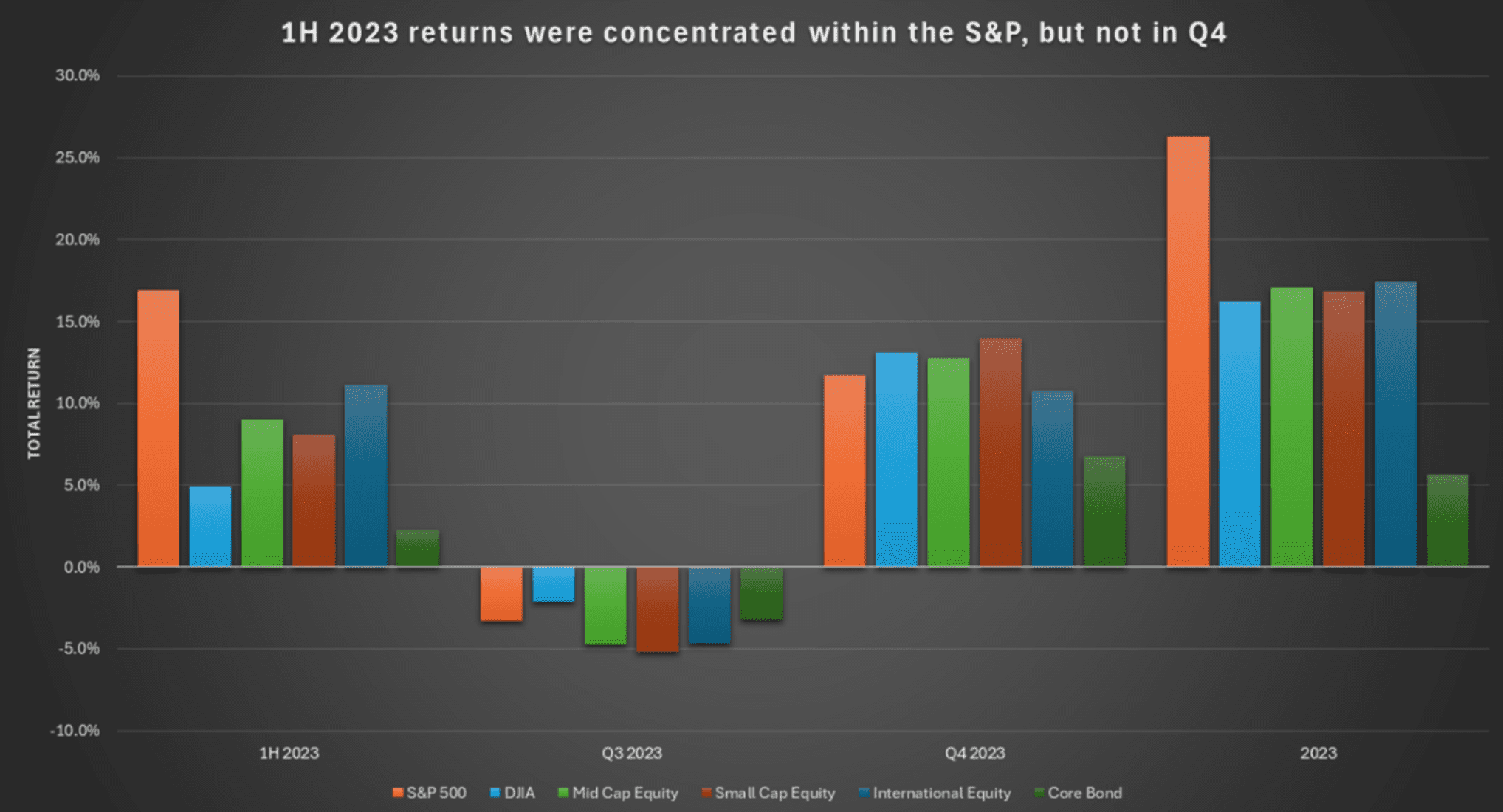Given all the tumultuous developments in the first quarter this year, would you believe it if I told you stocks and bonds posted positive performance? Despite the largest bank failure since the Financial Crisis (and second largest in our history), two additional Federal Reserve interest rate increases, and hotter than expected inflation data, equities posted strong returns during the quarter, led by the riskiest segments of the market. Interestingly, the stocks that were hit hardest last year outperformed materially to begin 2023. For instance, the Nasdaq Composite underperformed the Dow Jones Industrial Average by 26% in 2022 but outperformed by 16% in Q1. Fixed income markets also posted strong returns due to a “flight to safety” amid stress in the banking sector. What can explain this? Several indicators we monitor suggest the market is pricing in the end of Federal Reserve tightening, and actually expects the Federal Reserve to ease monetary conditions before the end of the year. Easing of monetary conditions can give the market a sugar high, and cause a rabid rebound, as we have seen. However, the Fed will only cuts rates if the economy is weakening, and thus, market participants are welcoming a recession.
While we welcome positive returns, we will not ignore risks that are becoming more evident. A quick recovery in stocks due to a possible about-face from monetary officials is not a sustainable driver of long-term returns, especially when the effects of historic monetary tightening have yet to be fully felt throughout the broad economy. We already see various economic and market indicators pointing to weakness ahead: Inflation-adjusted measures of spending are quickly losing momentum, gauges of business and consumer sentiment have trended lower for several months, a recessionary signal in interest rate markets is at its lowest level ever, and commodity prices, a gauge for global economic demand, are down 20-60% since last year. Additionally, recent stress in the banking sector all but guarantees banks will pull back credit availability, something that precedes all recessions. Therefore, we continue to believe we will enter a recession later this year, and the severity of the recession will depend, in part, on how aggressive the Fed continues to be.
Enough Juice for the Squeeze?
Market performance in the first quarter, particularly risk assets such as stocks, suggests the risk of a recession is being ignored. Instead, market participants are expecting a Fed “put,” a term that refers to the Fed cutting rates and saving markets when things start to get choppy. This approach, in my opinion, ignores the broader effect a recession will have on corporate fundamentals. In fact, corporate earnings expectations from professional forecasters still reflect a normal economic environment. To be aggressive in this market, one must have absolute conviction in a Fed “put” and the U.S. avoiding recession altogether, and even then, the investor would earn only average returns at current levels. As Jaime Benedetti would say, stocks do not currently offer a lot of juice for the squeeze. We prefer to be aggressive when prices reflect poor conditions, and thus provide more juice with an easier squeeze. We do not see that opportunity today. One may wonder, “If that’s the case, why invest in equities at all?
Two main reasons:
1.The above scenario where an investor earns only an average return is very much in play. Several indicators we monitor suggest a Fed put is already being priced in, in which case, it’s possible we have already hit the bottom of markets in this cycle.
2.We cannot predict the future, but we can control risk. While a scenario of average returns is not a time to be aggressive, it is also not a time to be on the sideline. Missing out on returns can have substantial negative effects on the success of your financial plan, which is a risk itself. Portfolios always need juice.
Enhancing Protection
So how do we protect ourselves in an uncertain environment while still capturing upside if we continue to grind higher? We believe this can be accomplished in a three-pronged approach. First, we maintain index-like equity allocations, this helps us in a scenario where we grind higher. Second, we make tactical adjustments within our equity allocations, away from businesses most exposed to an economic slowdown, and towards those least exposed, reducing our exposure to a severe contraction in earnings estimates. And last, we enhance our equity “hedge.” In this case, our hedge is our bond portfolio, but more specifically, it’s an allocation to U.S. Treasuries. Treasury bonds have historically been the best performing asset class during recessions and Federal Reserve easing cycles. And wouldn’t you know it, their yields are the highest they have been in over 15 years. We believe we can use the recent rally to play defense and respect the risk of a recession, while not abandoning risk assets that may continue to climb. We also believe, given the level of interest rates, we are being paid to be patient, and that’s an opportunity we have not had in a long time.



